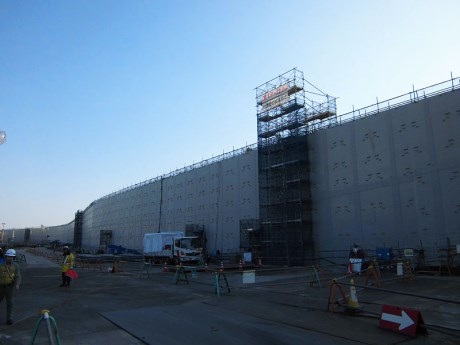Chubu Electric Power Company is to implement a set of new safety measures based on revised Japanese regulatory requirements at Hamaoka units 3 and 4 with a view to applying for permission to restart its only nuclear power plant.
 |
| Hamaoka's 22-metre-high tsunami protection wall was completed in December 2012 (Image: Chubu) |
Work to enhance functions which would enable the units to respond to earthquakes, tsunamis, tornadoes, fires and severe accidents will commence at Hamaoka 4, moving on to unit 3, and is expected to be completed by the end of September 2015 for unit 3 and September 2016 for unit 4. Additional measures for Hamaoka 5 are still being investigated.
The three operable units at Hamaoka were all built to earthquake-resistant design standards. Two earlier units, Hamaoka 1 and 2, were permanently closed down in 2009.
Measures to be taken include reinforcement of supports for pipes and cable-related equipment plus ground reinforcements at various points around the site to enhance earthquake resistance. Steps will be taken to protect outdoor seawater pumps and pipes, already designed to withstand the strong winds of typhoons, from potential impact by objects caught up in tornadoes, while protection against fire, floods and tsunamis and numerous other emergency measures will be further enhanced.
The new measures are in response to revised regulations announced by Japan's Nuclear Regulation Authority (NRA) earlier this year, which must be met before plants can secure regulatory permission to restart. The new regulations set out essential requirements enabling plants to respond to a variety of natural phenomena as well as establishing new requirements to mitigate the effects of severe accidents, such as reactor core damage caused by beyond design basis events.
Chubu is already working to implement enhanced sea defences at Hamaoka, which sits in a region of high seismic activity where there is a high risk of a major earthquake and tsunami within the next 30 years. A 22-metre high tsunami protection wall, 1.6 km in length, was completed in December 2012, with other work including flood prevention measures at site buildings and extensive measures to enhance emergency reactor cooling functions. These works were expected to be completed by the end of 2013.
As soon as the NRA's new regulations were announced in June, four Japanese utilities lodged applications for permission to restart their reactors. Chubu said that it is proceeding with the necessary preparations to enable it to make "applications related to conformity with new regulatory requirements" as soon as possible within the current fiscal year. "We believe that the implementation of these additional measures will make units 3 and 4 fully compliant with the new regulatory requirements in terms of facility- and equipment-based measures," the company stated.
Researched and written
by World Nuclear News




_18570.jpg)
_18938.jpg)
_33584.jpg)
_82983.jpg)





